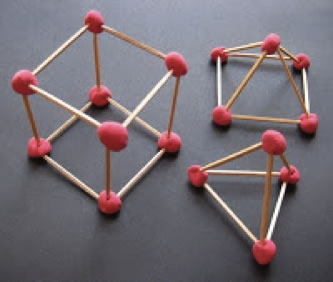3D Forms
In this lesson, children will construct various three-dimensional objects using toothpicks and modeling clay.
Lesson for:
Toddlers/Preschoolers
(See Step 5: Adapt lesson for toddlers or preschoolers.)
Content Area:
Geometry
Learning Goals:
This lesson will help toddlers and preschoolers meet the following educational standards:
- Analyze characteristics and properties of two- and three-dimensional geometric shapes and develop mathematical arguments about geometric relationships
- Use visualization, spatial reasoning and geometric modeling to solve problems
Learning Targets:
After this lesson, toddlers and preschoolers should be more proficient at:
- Recognizing, naming, building, drawing, comparing and sorting two- and three-dimensional shapes
- Describing attributes and parts of two- and three-dimensional shapes
- Investigating and predicting the results of putting together and taking apart two- and three-dimensional shapes
- Creating mental images of geometric shapes using spatial memory and spatial visualization
- Recognizing and representing shapes from different perspectives
- Recognizing geometric shapes and structures in the environment and specifying their location

3D Forms
Lesson plan for toddlers/preschoolers
Step 1: Gather materials.
- Toothpicks
- Clay (Model Magic works well)
- Mini marshmallows, gum drops, raisins or jelly beans can also be used
- Pictures of a cube, a square-based pyramid and a tetrahedron
Note: Small parts pose a choking hazard and are not appropriate for children age five or under. Be sure to choose lesson materials that meet safety requirements.
Step 2: Introduce activity.
- Show the children two-dimensional and three-dimensional shapes and explain how they are different.
- Ask the children what they notice about the two different types of shapes.
- Explain the difference between two-dimensional shapes and three-dimensional shapes:
- Two-dimensional shapes have two dimensions: length and width.
- Three-dimensional shapes have three dimensions: length, width and height.
Step 3: Engage children in lesson activities.
- Show the children how to form equal-sized balls of clay (about the size of large peas).
- Stick toothpicks into the clay to form the basic shapes of a tetrahedron, a square-based pyramid and a cube.
- Model how to make another cube, use four more toothpicks on each face of your cube to form new square-based pyramids. Explain that the pyramids in Egypt are square-based pyramids.
- Introduce vocabulary such as face, edge and vertice.

- Ask the children to build each of the four shapes and review vocabulary using their shapes as examples.
- Ask the children to count how many faces each of their shapes have. How many vertices (corners) do each of their shapes have? How many edges do each of their shapes have? Keep a record sheet of their information.
Additional Extensions
- Toothpick sculptures are great for group projects. Give the children a challenge or a problem to solve (like designing a car of the future) and watch them get creative. Group members can work together to create a sculpture or an imaginary animal and then give a short presentation about their construction. The sky’s the limit!
- Give the children two sticks of different sizes (one stick should be the length of a toothpick and the other stick should be longer). The children can use these sticks to make spheres, cuboids and other three-dimensional shapes.
Step 4: Vocabulary.
- Two-dimensional: A shape having two dimensions: length and width
- Three-dimensional: A shape having three dimensions: length, width and height
- Cube: A solid shape that has six square faces that are equal in size, eight vertices (corners) and 12 equal edges
- Tetrahedron: A pyramid with four faces that are all triangles
- Square-based pyramid: A pyramid with four triangular faces and one square face
- Face: A flat surface of a three-dimensional shape
- Vertice: The corner (the point where the edges of a solid figure meet)
- Edge: The side of a polygon where two faces of a solid figure meet
Step 5: Adapt lesson for toddlers or preschoolers.
Adapt Lesson for Toddlers
Toddlers may:
- Have difficulty with their fine motor skills
- Have difficulty visualizing and/or constructing the 3D shapes
Child care providers may:
- Roll the balls of clay prior to the activity
- Help position the toothpicks and clay balls so that the children can focus on construction, without getting frustrated by trying to balance the balls of clay and position the toothpicks in the clay balls
- Allow the children to build freely with the toothpicks and balls of clay (take your teaching cues from the children’s construction and ask the children to explain what they built)
Adapt Lesson for Preschoolers
Preschoolers may:
- Easily construct the three-dimensional objects
- Have a real aptitude for building and a solid sense of spatial reasoning
Child care providers may:
- Give the children sticks two sticks of different sizes (one stick should be the length of a toothpick and the other stick should be longer) and ask the children to make spheres, cuboids and other three-dimensional shapes with the sticks
- Give the children a challenge or a problem to solve (like designing a car of the future) and watch them get creative. Group members can work together to create a sculpture or an imaginary animal and then give a short presentation about their construction.
Suggested Books
- When a Line Bends….A Shape Begins by Rhonda Greene (New York: HMH Books for Young Readers, 2001)
Music and Movement
Outdoor Connections
Using the toothpicks and balls of clay, move outside and ask the children to build structures they see outside. They can build their school, their house or even design a cool new playground. Working together as a group, they can build their neighborhood.

Comment on this lesson